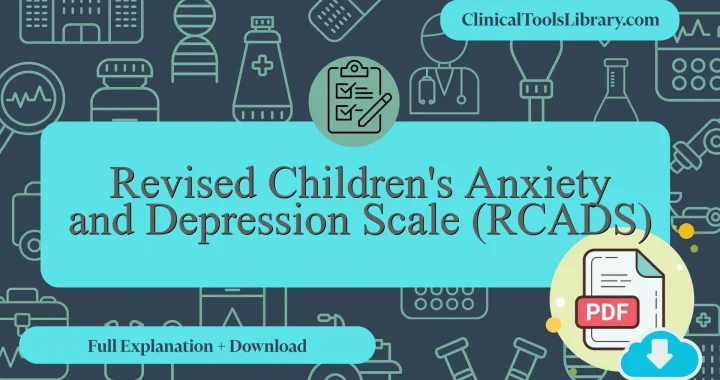In this article, we explain everything you need to know about the FLACC Scale. We will cover the aspects it evaluates, the target population, a detailed step-by-step explanation, and how to interpret its results. Additionally, we will dive into the scientific evidence supporting this tool (diagnostic sensitivity and specificity) in clinical assessment. You will also find official and unofficial sources available for download in PDF format.
What does the FLACC Scale assess?
The FLACC Scale is a validated observational tool designed to assess pain intensity in patients who are unable to communicate effectively, particularly in pediatric populations, typically ages 2 months to 7 years. It evaluates five behavioral categories: Face, Legs, Activity, Cry, and Consolability, each scored from 0 to 2, producing a total score indicative of pain severity. The primary purpose of the FLACC pain scale is to provide an objective measure to guide pain management decisions in clinical settings. While originally developed for children, adaptations of the FLACC scale for adults with cognitive impairments have been explored. The scale is distinct from other tools such as the PAINAD scale and the Wong-Baker pain scale, both of which serve different patient populations and communication abilities. Accurate FLACC pain scale score interpretation facilitates timely and appropriate analgesic interventions.
For which type of patients or populations is the FLACC Scale intended?
The FLACC scale is primarily indicated for assessing pain in non-verbal pediatric patients, particularly infants and young children between the ages of 2 months and 7 years who are unable to self-report. It is most useful in clinical contexts such as postoperative care, pediatric intensive care units, and during procedures where behavioral and physiological indicators must be evaluated systematically. The tool evaluates five categories—Face, Legs, Activity, Cry, and Consolability—to provide an objective pain score, facilitating appropriate pain management. While originally designed for children, recent studies have explored the FLACC scale for adults with cognitive impairments or severe communication barriers, including those with non-verbal dementia. Compared to self-report tools like the Wong-Baker pain scale, the FLACC scale offers a validated alternative for populations where subjective reporting is impractical, ensuring pain is adequately identified and addressed.
Step-by-Step Explanation of the FLACC Scale
The FLACC Scale consists of five items assessing Facial expression, Leg movement, Activity, Cry, and Consolability. Each item includes descriptive behavior-based questions scored on a three-point scale from 0 to 2, where 0 indicates no distress and 2 indicates pronounced distress or pain behaviors. Scores are summed to produce a total between 0 and 10, with higher totals reflecting greater pain intensity. The observer must evaluate behaviors during rest and activity, noting differences in muscle tension, movement patterns, vocalizations, and response to comfort measures. This scale is particularly useful for non-verbal pediatric patients or individuals with cognitive impairments, facilitating objective pain assessment in clinical settings.
FLACC Pain Scale PDF Resources: Original & English Versions with Score Interpretation Guide
Downloadable resources featuring the FLACC pain scale are available below in both the original and English versions, provided in convenient PDF format. These documents serve as essential tools for assessing discomfort in non-verbal patients and include guidance on FLACC pain scale score interpretation. The materials cater to various clinical settings, ensuring accurate application across age groups and conditions where the FLACC scale for adults may be applicable.
How to interpret the results of the FLACC Scale?
The FLACC Scale is a behavioral tool used to assess pain in pediatric patients unable to communicate verbally, with scores ranging from 0 to 10 based on five categories: Face, Legs, Activity, Cry, and Consolability. Interpretation involves summing individual scores, where 0 indicates no pain, 1–3 suggests mild discomfort, 4–6 corresponds to moderate pain, and 7–10 reflects severe pain requiring intervention. For example, a patient exhibiting a face score of 2, leg activity of 1, and cry rating of 2 results in a total score of 5, indicating moderate pain. Healthcare professionals utilize these values to guide analgesic administration and monitor treatment efficacy, ensuring timely adjustments to pain management plans in conditions such as postoperative recovery or acute injury. The objective scoring aids in reducing subjective bias, thereby improving patient outcomes through standardized pain assessment.
What scientific evidence supports the FLACC Scale ?
The FLACC Scale, developed in 1997 by Merkel et al., is a well-validated observational tool designed to assess pain in pediatric patients who are unable to communicate effectively. It evaluates five criteria: Face, Legs, Activity, Cry, and Consolability, each scored to quantify pain intensity. Numerous studies have confirmed its reliability and validity across various clinical settings, including postoperative care and patients with cognitive impairments. Research published in peer-reviewed journals demonstrates strong inter-rater consistency, with correlation coefficients frequently exceeding 0.8. Its sensitivity in detecting pain-related behaviors makes it particularly useful in managing conditions such as neonatal pain and assessing discomfort in children with neurological disorders. This evidence underscores the scale’s widespread acceptance as a standard for pain assessment in non-verbal pediatric populations.
Diagnostic Accuracy: Sensitivity and Specificity of the FLACC Scale
The FLACC Scale demonstrates a sensitivity ranging from approximately 0.75 to 0.92 in detecting pain levels in non-verbal pediatric patients, indicating a high probability of correctly identifying those experiencing pain. Specificity values reported in clinical studies vary between 0.70 and 0.90, reflecting its effectiveness in distinguishing patients without significant pain behaviors. These metrics underscore the scale’s reliability across diverse clinical settings, particularly in assessing pain in infants and children with conditions such as postoperative pain and neurological impairments. However, variability in sensitivity and specificity may occur depending on the evaluator’s training and the patient population assessed.
Related Scales or Questionnaires
The FLACC pain scale, primarily designed for assessing pain in young children and non-verbal patients, shares similarities with other observational tools such as the PAINAD scale, which is tailored for individuals with dementia. Both scales focus on behavioral indicators rather than self-reporting, making them valuable in populations unable to communicate pain effectively. Another comparable instrument is the Wong-Baker pain scale, which uses facial expressions but requires some level of patient interaction, limiting its use in non-verbal or very young patients. Advantages of the FLACC scale include its simplicity and applicability across various pediatric age groups (FLACC scale age), while its disadvantages involve potential subjectivity and variability among raters. The PAINAD scale is advantageous in chronic neurodegenerative conditions but may not capture acute pain nuances as effectively. The Wong-Baker scale facilitates quick assessment with pictorial references but does not suit non-verbal patients. These and other relevant scales or questionnaires are thoroughly explained and available for download on ClinicalToolsLibrary.com, where additional resources like the FLACC pain scale pdf and guidance on FLACC pain scale score interpretation can also be accessed.




